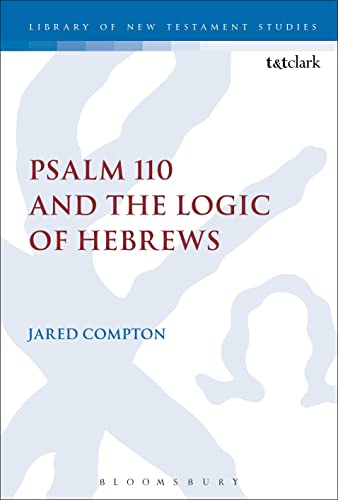Psalm 110 and the Logic of Hebrews
Written by Jared Compton Reviewed By George H. GuthrieJared Compton currently serves as a pastor of Crossway Community Church in Bristol, Wisconsin. Based on a PhD dissertation written under the supervision of D. A. Carson at Trinity Evangelical Divinity School, Psalm 110 and the Logic of Hebrews explores the function of the Old Testament, particularly Psalm 110, in the structure and logical development of the New Testament book of Hebrews (p. 1). The study develops over five chapters, with back matter consisting of an appendix surveying literature on the use of the Old Testament in Hebrews’ structure, a bibliography, an index of references, and an index of authors.
In the introductory chapter, Compton follows G. W. Buchanan’s observation that Psalm 110, especially verses 1 and 4, is a critical piece in unlocking the book’s logical development and structure. The balance of the chapter offers a brief review of three works that have dealt substantively with the use of Psalm 110 in Hebrews’s structure, a plan and preview of the study, an overly brief quarter page on “presuppositions” that lie behind the monograph, and finally the first of the monograph’s many excursuses.
Chapters 2–4 analyze the logic of three main movements in the expositional material of Hebrews: Hebrews 1–2, Hebrews 5–7, and Hebrews 8–10. For instance, chapter 2 on Hebrews 1–2 considers the internal logic of Hebrews 1:5–14, 2:5–9, and 2:10–18. Compton then proposes how Psalm 110 plays a significant role in each movement and concludes each chapter with a synthesis of his findings.
Further, the author punctuates chapters 1–4 with ten excursuses on a wide variety of topics, for example, “Hebrews’ Audience and Situation” (Chapter 1), “Σωφία and Λόγος Traditions in Early Judaism and in Hebrews” (Chapter 2), and “Melchizedek’s Identity” and “The High Priest’s Daily Sacrifice” (Chapter 3). Chapter 4 alone has five excursuses! Although these excursuses are substantive summaries on the topics addressed, some readers may find them distracting from the primary research question. Chapter 5, as the conclusion of the study, summarizes the logic of Hebrews and offers suggested implications for Hebrews’s situation.
Psalm 110 and the Logic of Hebrews presents a thoughtful analysis of one vital aspect of Hebrews’s purpose and structural development. Copious footnotes throughout point to a depth of research, and the approach of “filtering” the book’s expositional units through the lens of what is undoubtedly the key Old Testament passage for the author, lends a cohesiveness to the argument and interesting perspectives on Hebrews’s theology and rhetorical goals.
At the same time, the basic approach followed in the monograph, where the internal logic of the expositional units is considered in relative isolation, may at points be seen as obscuring the clarity of Hebrews’s structure. Compton follows George Guthrie (The Structure of Hebrews: A Text-linguistic Analysis [Leiden: Brill, 1994], 115) in considering the benefit of discerning the expositional material’s specific semantic program. However, part of the benefit of such discernment has to do with a heightened awareness of how that content then integrates both rhetorically and theologically as it interplays with the book’s introduction and sections of hortatory material. For example, although mentioning the allusion to Psalm 110:1 at Hebrews 1:3, Compton does little to establish the expositional material in contextual relationship to this vital launch of the book’s use of Psalm 110, and the exaltation in 1:3 as a referent inclusive of the Son’s resurrection—a key question in recent Hebrews research—is more assumed on the basis of the work of others than it is argued. At a number of points throughout, the reflections could have been strengthened by establishing more firmly the rhetorical role the expositional passage plays vis-à-vis the surrounding material.
Nevertheless, Compton argues his case well that at every point in the development of the book’s Christology, Psalm 110 looms large as a primary backdrop. Even passages like 2:10–18 and 9:1–10, where the psalm’s role recedes, giving way before other focal Old Testament texts or topics, its presence is still felt. Furthermore, the conclusion that the author uses the psalm, in part, to make a case for a suffering messiah, offers a fresh focus on the use of this important passage in early Christianity.
George H. Guthrie
George H. Guthrie
Union University
Jackson, Tennessee, USA
Other Articles in this Issue
A Missiology of Excluded Middles: An Analysis of the T4T Scheme for Evangelism and Discipleship
by George A. TerryThis article analyzes the theological premises of the popular T4T model for evangelism and discipleship...
Jonathan Edwards provides subsequent generations of theologians and ministers with one of the most influential versions of the traditional account of hell...
The Preeminence of Knowledge in John Calvin’s Doctrine of Conversion and Its Influence Upon His Ministry in Geneva
by Obbie Tyler ToddJohn Calvin believed that the mind served as the “citadel” to the soul, commanding the seat of conversion whereby God first remedied the noetic effects of sin before liberating the bound will...
Wendell Berry’s influence has grown in recent years as many people, Christians or not, have found his agrarian vision a compelling corrective to various modern problems...
Underlying the atheistic naturalist’s argument from evil against God’s existence is an assumed knowledge of evil—they know what evil is...







